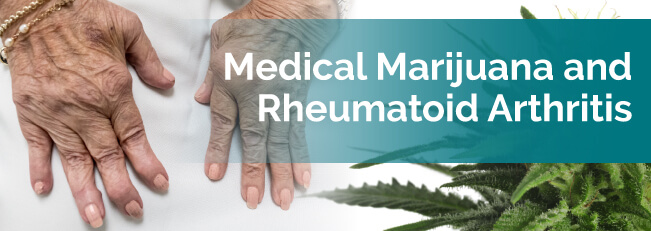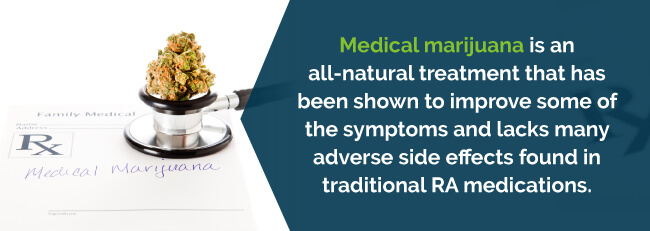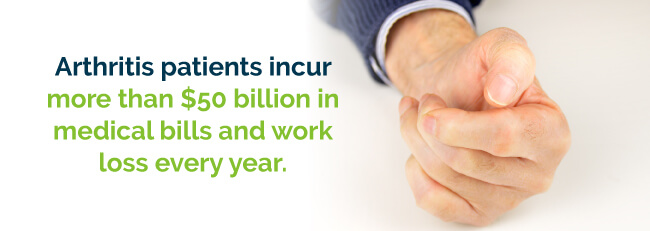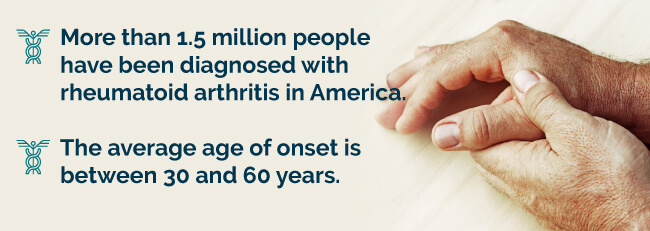
The most common cause of disability in America is arthritis. Millions of Americans experience this disorder. As the baby boomer generation enters their golden years, the number of arthritis patients will continue to climb.
There are more than 100 different types of arthritis, and the common feature of each is joint pain and inflammation. Rheumatoid arthritis (RA) presents itself differently than many other types of arthritis. It is an autoimmune disease, as opposed to a joint disorder, and it causes inflammation throughout all the body’s connective tissues.
As the number of sufferers continues to climb, patients are looking for relief. There is no cure, but if the condition is caught early, extended periods of remission are possible.
Medical marijuana has proven to be an effective treatment for rheumatoid arthritis. Not only does it act as an effective pain reliever, but the medicinal properties associated with the herb may also be just what the doctor ordered. Read more to see if cannabis treatments could be the answer you seek.
It’s important for RA patients to manage their condition, so many are looking for safer and more affordable alternatives. Using medical marijuana for rheumatoid arthritis is an all-natural treatment that has been shown to improve some of the symptoms associated with the disorder. An added benefit is that it lacks many adverse side effects found in traditional RA medications.
Find A Doctor Find A Dispensary

Those using cannabis for rheumatoid arthritis have seen excellent results, including:
Research studies in this field show scientific evidence that medical marijuana is an effective therapy for arthritis and, more specifically, RA. Cannabis has proven pain-relieving properties. It can be used by itself or in combination with other painkillers, safely and effectively controlling the pain caused by RA.
One of the core symptoms of arthritis is inflammation. There is both research and anecdotal evidence that marijuana acts as an anti-inflammatory. This gives RA patients relief from inflamed joints.
The endocannabinoid system controls the general homeostasis of every person, and acts as a bridge between our body and our mind. Certain conditions, like arthritis, cause our endocannabinoid system to be out of whack. Compounds found in cannabis target cannabinoid receptors present in the synovium of joints, bringing targeted relief from painful symptoms.
As patients find relief from their RA symptoms because of medical marijuana, it becomes a more accepted mode of treatment. The following symptoms are showing great improvements because of cannabis.
The cannabinoid compounds tetrahydrocannabinol (THC) and cannabidiol (CBD) found in marijuana have proven medical properties. Among these is pain relief. Certain strains of marijuana can target pain and bring much-needed relief.
Best strains: Canna Tsu, Death Bubba, Girl Scout Cookies
Multiple cannabinoids in marijuana work to reduce inflammation. These include CBD and THC, as well as CBC, CBDa, CBG, CBN and THCa.
Best strains: Blue Dream, Granddaddy Purple, Gorilla Glue #4

Because of chronic pain and the general malaise caused by RA, fatigue is a common symptom in many patients. The Indica strain of marijuana is known for its sleep-inducing properties. And a well-rested patient is far more likely to have a better chance of remission.
Best Strains: Skywalk, God’s Gift, Afghan Kush
If patients are in the midst of an RA flare-up, they may also suffer from feelings of anxiety and depression. The chronic nature of the disorder can cause patients to feel hopeless. Medical marijuana is shown to relieve both anxiety and depression and give patients an improved outlook on life.
Best Strains: Holy Grail Kush, Tahoe OG Kush, Jack Herer
Because rheumatoid arthritis can lead to lung issues, smoking cannabis products is not recommended. However, there are many safer ingestion alternatives, including:
If you have rheumatoid arthritis and you need medical advice about cannabis treatments, let us connect you with hundreds of qualified marijuana doctors near you.
Find A Doctor Find A Dispensary
Because arthritis is the most common disorder in the U.S., the costs associated with it are astronomical. One study indicates that arthritis patients incur more than $50 billion in medical bills and work loss every year.

Rheumatoid arthritis does not follow the same rules as other types of arthritis. It’s not just a joint disorder — it’s an autoimmune disease. For reasons no one quite knows, the immune system goes into overdrive and begins attacking healthy body tissue.
Arthritis is commonly associated with the elderly, but RA affects more than just senior citizens. In fact, the average age of onset is from 30 to 60 years of age. There are even cases of children having early-onset RA.
As the immune system attacks the body’s joints, they become swollen and inflamed, leading to chronic pain. The most important joints in the body are commonly affected, including the:
However, RA can affect more than just the joints. As this systemic disorder progresses, it can weaken other parts of the body, organs and systems, such as:
The progression of RA is typically slow. However, once damage occurs, it’s irreversible. That’s why early diagnosis and the initiation of treatment is so important.
No one test can confirm a rheumatoid arthritis diagnosis. Usually, your physician or a rheumatologist, a doctor specializing in RA, will have to verify it using a combination of the following results:

The immune system is the “bodyguard” of the human body. It protects us against assaults such as infections, foreign bodies and wounds. Inflammation is a common byproduct of the immune system in action.
In RA patients, something goes haywire. The immune system produces specialized cells and chemicals that get released into the bloodstream, misdirecting inflammation into the body’s joints.
The synovial membrane (synovium), a protective tissue which lines joints, thickens and becomes inflamed. Inflammation of the synovium is the hallmark of RA, and is called synovitis. If left untreated, the synovitis expands both inside and outside of the joint. This is what causes damage to other parts of the body.
Though doctors understand the workings of rheumatoid arthritis, no one really knows why it occurs. There are some factors that may contribute, including:
The symptoms associated with rheumatoid arthritis have the potential to be more severe than other types of arthritis as the condition develops. Because of this, it’s important patients begin treating RA as close to onset as possible. If you believe you suffer from this disorder, listen to your body for clues. Early indicators may be hard to detect. These include:
Throughout the progression of the disorder, symptoms vary from person to person. Patients go from periods of increased symptoms — or flare-ups — to long spans of time where there are no apparent symptoms — or remission.
Interestingly, RA usually affects the body symmetrically. If there are complications on one side of the body, these often are mirrored on the other side.
Common symptoms of RA include:
If left untreated, RA can lead to loss of function, severe deformities or even disability. Symptoms that could point to more serious complications include:
The pain associated with rheumatoid arthritis can leave patients unable to function for extended periods of time. This could affect a person’s job, personal relationships and even psychological health. RA patients commonly suffer from mental illnesses such as:
This condition is not fatal. However, it can lead to premature death because of the complications that arise, as well as treatment-related side effects.
There is no cure for rheumatoid arthritis, but early diagnosis and treatment are crucial. If left unmanaged, permanent bone or cartilage damage can occur within the first year. Medical treatments and therapy allow patients to continue living happy lives. The goals of any course of RA treatments are:
Many treatments and therapies exist for rheumatoid arthritis patients. The most popular include the following.
There are many medications used to treat RA. Depending on the progression of the disorder, doctors will prescribe what they feel suits you best. However, many of these drugs can cause serious side effects.
An active lifestyle is just as important as medication for RA patients. Low-impact exercises like yoga and walking reduce inflammation. It’s also important that RA patients maintain a healthy weight, as being overweight increases risk factors.
Physical therapists work with patients to determine a workout regimen that keeps joints working and flexible. The only downside to this is that RA patients may still find physical activity extremely painful, leading to increased frustration.
Those with pain caused by alignment issues may benefit from these treatments, which focus on manipulating affected joints to bring relief.
However, many health care professionals caution against chiropractics because manipulating joints could worsen the condition and increase pain, especially if joints are inflamed.
Invasive surgery is only used to treat drastic issues and severe joint damage. Any deformities caused by RA are irreversible, but surgery can restore some abilities that may have been lost. It can also repair some parts of the joint. The most common RA operations include:
Surgery always comes with its own sets of risks and potential side effects, which should be discussed with your physician.
Some patients have shown improvement by using holistic remedies and therapies. These include:
The downsides of these types of treatments are that they either only last a short amount of time before they need to be repeated, or they prove ineffective.